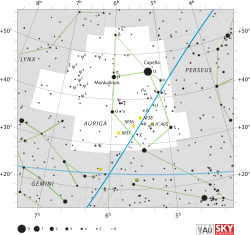Zeta Aurigae

| |
| Observation data Epoch J2000 Equinox J2000 | |
|---|---|
| Constellation | Auriga |
| Right ascension | 05h 02m 28.68739s[1] |
| Declination | +41° 04′ 33.0200″[1] |
| Apparent magnitude (V) | 3.751[2] (3.70 - 3.97[3]) |
| Characteristics | |
| Spectral type | K5 II + B7 V[4] |
| U−B color index | +0.374[2] |
| B−V color index | +1.293[2] |
| R−I color index | 0.87 |
| Variable type | Algol[3] |
| Astrometry | |
| Radial velocity (Rv) | +12.8[5] km/s |
| Proper motion (μ) | RA: +9.45[1] mas/yr Dec.: -20.71[1] mas/yr |
| Parallax (π) | 4.15 ± 0.29[1] mas |
| Distance | 790 ± 50 ly (240 ± 20 pc) |
| Orbit[6] | |
| Period (P) | 972.162 d |
| Semi-major axis (a) | 905 R☉ |
| Eccentricity (e) | 0.3973 ± 0.0007 |
| Inclination (i) | 87.0° |
| Periastron epoch (T) | Reduced JD 53039.9 ± 0.10 |
| Argument of periastron (ω) (secondary) | 328.9° ± 0.13° |
| Semi-amplitude (K1) (primary) | 23.17 ± 0.02 km/s |
| Details | |
| ζ Aur A | |
| Mass | 4.94 ± 0.79[7] M☉ |
| Luminosity | 3,254[7] L☉ |
| Surface gravity (log g) | 1.33[8] cgs |
| Temperature | 3,920[8] K |
| Metallicity [Fe/H] | –0.26[8] dex |
| Rotational velocity (v sin i) | 68[9] km/s |
| ζ Aur B | |
| Mass | 4.8[6] M☉ |
| Other designations | |
Zeta Aurigae (ζ Aur, ζ Aurigae) is the Bayer designation for a binary star system in the northern constellation of Auriga. It has the traditional names Haedus and Sadatoni. Based upon parallax measurements made during the Hipparcos mission, this system is approximately 790 light-years (240 parsecs) distant from the Earth. It has a combined apparent visual magnitude of 3.75,[2] which is bright enough to be seen with the naked eye.
This is an eclipsing binary system with the orbital plane being oriented close to the line of sight from the Earth; the inclination of this system is estimated as 87.0°.[6] As a result, an eclipse of one star by the other occurs during each orbit, causing the magnitude to decrease to +3.99. The pair have an orbital period of 972 days (2.66 years) and an eccentricity of 0.4.[6] The primary component has been categorized as a K-type bright giant or supergiant star. Its companion is a B-type main sequence star of stellar classification B5 V or B7 V.[6][4]
Etymology
It has the traditional names Haedus (also Hoedus) and Sadatoni (rarely Saclateni). It is one of the two hædi (kids) of the she-goat Capella, the other being Hoedus II, Eta Aurigae. The name Sadatoni is from the Arabic الساعد الثاني as-sācid aθ-θānī "the second arm (of the charioteer)". The rare traditional name Azaleh is shared (in the form Hassaleh) with Iota Aurigae.
In Chinese, 柱 (Zhù), meaning Pillars, refers to an asterism consisting of ζ Aurigae, ε Aurigae, η Aurigae, υ Aurigae, ν Aurigae, τ Aurigae, χ Aurigae and 26 Aurigae.[11] Consequently, ζ Aurigae itself is known as 柱二 (Zhù èr, English: the Second Star of Pillars.)[12]
References
- 1 2 3 4 5 van Leeuwen, F. (November 2007), "Validation of the new Hipparcos reduction", Astronomy and Astrophysics, 474 (2): 653–664, arXiv:0708.1752
 , Bibcode:2007A&A...474..653V, doi:10.1051/0004-6361:20078357.
, Bibcode:2007A&A...474..653V, doi:10.1051/0004-6361:20078357. - 1 2 3 4 Kiyokawa, M. (1967), "Photoelectric Observation of Zeta Aurigae during the 1963-64 Eclipse", Publications of the Astronomical Society of Japan, 19: 209, Bibcode:1967PASJ...19..209K.
- 1 2 Samus, N. N.; Durlevich, O. V.; et al. (2009). "VizieR Online Data Catalog: General Catalogue of Variable Stars (Samus+ 2007-2013)". VizieR On-line Data Catalog: B/gcvs. Originally published in: 2009yCat....102025S. 1. Bibcode:2009yCat....102025S.
- 1 2 Shenavrin, V. I.; Taranova, O. G.; Nadzhip, A. E. (January 2011), "Search for and study of hot circumstellar dust envelopes", Astronomy Reports, 55 (1): 31–81, Bibcode:2011ARep...55...31S, doi:10.1134/S1063772911010070.
- ↑ Wilson, R. E. (1953), General Catalogue of Stellar Radial Velocities, Carnegie Institute of Washington, D.C., Bibcode:1953GCRV..C......0W.
- 1 2 3 4 5 Eaton, Joel A.; Henry, Gregory W.; Odell, Andrew P. (June 2008), "Orbits and Pulsations of the Classical ζ Aurigae Binaries", The Astrophysical Journal, 679 (2): 1490–1498, arXiv:0802.2238
 , Bibcode:2008ApJ...679.1490E, doi:10.1086/587452.
, Bibcode:2008ApJ...679.1490E, doi:10.1086/587452. - 1 2 Hohle, M. M.; Neuhäuser, R.; Schutz, B. F. (April 2010), "Masses and luminosities of O- and B-type stars and red supergiants", Astronomische Nachrichten, 331 (4): 349, arXiv:1003.2335
 , Bibcode:2010AN....331..349H, doi:10.1002/asna.200911355.
, Bibcode:2010AN....331..349H, doi:10.1002/asna.200911355. - 1 2 3 McWilliam, Andrew (December 1990), "High-resolution spectroscopic survey of 671 GK giants" (PDF), Astrophysical Journal Supplement Series, 74: 1075–1128, Bibcode:1990ApJS...74.1075M, doi:10.1086/191527. origin: STI
- ↑ Bernacca, P. L.; Perinotto, M. (1970), "A catalogue of stellar rotational velocities", Contributi Osservatorio Astronomico di Padova in Asiago, 239 (1), Bibcode:1970CoAsi.239....1B.
- ↑ "zet Aur -- Eclipsing binary of Algol type (detached)", SIMBAD Astronomical Database, Centre de Données astronomiques de Strasbourg, retrieved 2012-08-19.
- ↑ (Chinese) 中國星座神話, written by 陳久金. Published by 台灣書房出版有限公司, 2005, ISBN 978-986-7332-25-7.
- ↑ (Chinese) 香港太空館 - 研究資源 - 亮星中英對照表 Archived January 29, 2011, at the Wayback Machine., Hong Kong Space Museum. Accessed on line November 23, 2010.